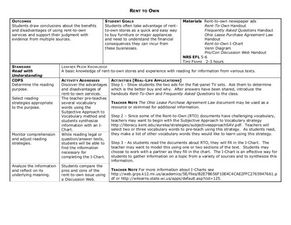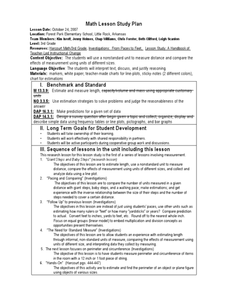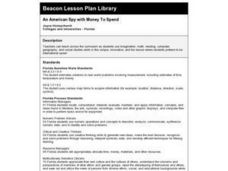Curated OER
Algebra 1: Simplifying Radicals
After discussing the difference between rational and irrational numbers, the class pratices simplifying, adding, and subtracting radical expressions. They play a game which involves passing around cards until they have matching hands of...
Curated OER
Simplify Radicals
Learners are introduced to the concept of radicals and how to use them in various situations. They review rational and irrational numbers while simplifying different number sentences. They also practice factoring perfect squares.
Curated OER
Searching the Internet for Information
In this searching the Internet worksheet, students solve and complete 20 various short answer questions related to the Internet. First, they find information on the Internet and communicate that information to others via email. Then,...
Curated OER
Know Yourself
Eleventh graders explore the events of the Holocaust. In this cross curriculum lesson, 11th graders examine the differences between prejudice and discrimination. Students read various forms of literature and write journal entries.
Curated OER
And the Survey Says...
Create a survey and graph! In this graphing lesson, learners listen to a story about pets, create a survey for family and friends about what pets they own, and use the information to create a bar and line graph.
Curated OER
Exploring Biomes Lesson 3: Endangered Biomes
Future environmental scientists compare data from two different conservation strategies. Alone this lesson is sufficient, but as part of the Exploring Biomes unit produced by the Arizona Fish and Game Department, it becomes top-notch.
Curated OER
Rent To Own
Reading can be a good way to learn about many different things, like rent-to-own housing programs. Learners read informational resources about rent-to-own programs and how they work. They complete graphic organizers using the facts they...
Curated OER
Make a Windmill
Students explore Earth science by conducting an energy experiment in class. In this windmill lesson, students identify how wind has been used to pump water throughout history and the latest developments wind energy has produced. Students...
Curated OER
Energy Conservation Lesson 1: Fossil Fuels and the Ticking Clock
Students explore energy production by participating in a class discussion. In this renewable energy lesson, students discuss the differences between solar, coal, wind and fossil fuel energy sources and why some are better for the...
Discovery Education
Sonar & Echolocation
A well-designed, comprehensive, and attractive slide show supports direct instruction on how sonar and echolocation work. Contained within the slides are links to interactive websites and instructions for using apps on a mobile device to...
Curated OER
Rules of Exponents
Students solve problems involving exponents. Through a teacher led discussion, students explore the rules of exponents and create cards with "x's" on them. Given a division problem, students lay out "x's" to represent the numerator and...
Curated OER
Thermometers Rising
Third graders read a Fahrenheit thermometer from an actual thermometer. In groups, they are provided with ink pads and a thermometer stamp. They use the stamps on plain white paper and use red pencil to take the temperature readings.
Curated OER
Mother May I?
Third graders measure distance using nonstandard units of measure. In this measurement lesson, 3rd graders measure a given distance through the use of the game "Mother May I?" Student gather and compare data on how many "giant steps" and...
Curated OER
Which Is the Better Car Deal?
Learners investigate whether it is more economically sound to take a low financing rate or rebate when purchasing a car.
Curated OER
Geo Jammin' - Day 6, Lesson 20: Hail, Hail, the Gang's All Here
Students use shape puppets to review geometry content. They take turns singing songs, reading students poems, reciting class bulletin board notes and choral poems. They prepare for their summative assessments through play and interview...
Curated OER
Classroom Triangles
Students use bearing measurements to triangulate and determine objects' locations. Working in teams of two or three, students must put on their investigative hats as they take bearing measurements to specified landmarks in their...
Curated OER
Making It All Add Up!
Students use technology resources for problem solving. They complete math problems or integrated science problems dealing with math concepts using an online calculator.
Curated OER
Sandlapper Solutions
Students use mathematical thinking and reasoning to translate problems into mathematical language and thereby solve the problems. They extend their understanding of whole number operations to fractions and decimals by participating in...
Curated OER
Surprise Snack
Students prepare a simple recipe and engage in a surprise math lesson. They enjoy making a class book featuring their favorite recipes, and can host a party with members of the school staff once their snacks are prepared.
Curated OER
An American Spy with Money To Spend
Sixth graders use their imagination, math, reading, computer, geography, and social studies skills in this unique, innovative, and fun lesson where students pretend to be international spies!
Curated OER
Apples A"Peel" To Me
Second graders study the characteristics and uses for apples through this series of ten lessons. They look at the importance of apples in the US. They read literature about apples, graph, sort, and measure apples, and make apple snacks....
Curated OER
Crazy Putty Ratio
Second graders use knowledge of measurements and ratios to mix various combinations of liquid starch and glue. They chart their ratios, make observations, and write a summary of the activity. They mix their own batch of Crazy Putty to...
Curated OER
Critical Thinking Strategies
Students explore critical thinking strategies. In this critical thinking lesson, students evaluate multiple choice answers. Students note similarities between incorrect answers and discover how to compare and contrast incorrect and...
Curated OER
Here's Looking at You
High schoolers assess some common inherited traits which are easily observable and note their phenotype for the trait. Students compare their phenotypes to those of their parents and attempt to describe the pattern and manor of inheritance.

























